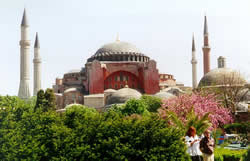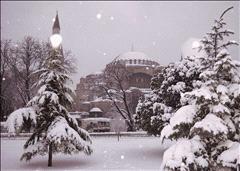|
|
|
|
| HAGIA SOPHIA MUSEUM
 Hagia Sophia, which is considered as one of the eight
wonders of the world, also occupies a prominent place in the
history of art and architecture. It is one of the rare works
of this size and age that has survived to our day. The
church (called Ayasofya in Turkish) is erroneously known as
Saint Sophia in the west. The basilica was not dedicated to
a saint named Sophia, but to Divine Wisdom.
Hagia Sophia, which is considered as one of the eight
wonders of the world, also occupies a prominent place in the
history of art and architecture. It is one of the rare works
of this size and age that has survived to our day. The
church (called Ayasofya in Turkish) is erroneously known as
Saint Sophia in the west. The basilica was not dedicated to
a saint named Sophia, but to Divine Wisdom.
This was the site of a pagan temple, and the three separate
basilicas built here in different times were all called by
the same name. Although no churches were built during the
reign of Constantine the Great, some sources maintain that
the first Hagia Sophia basilica was built by him. Actually,
the first small basilica with a wooden roof was constructed
in the second half of the 4th century by Constantinius, the
son of Constantine the Great.
This church burnt during the riots in 404, and a second and
larger basilica that replaced it was inaugurated in 415.
During the bloody uprising of 532 that broke out at a
chariot race in the Hippodrome, ten thousands of the
inhabitants of the city were killed and numerous building
destroyed.
The Hagia Sophia church was among the structures burnt
during this so-called "Nika" revolt which was directed
against Emperor Justinian.
When Justinian finally suppressed the revolt, he decided to
build a house of worship "the like of which has not been
seen since Adam, nor will it be seen in the future."
Construction started in 532 over the remains of the previous
basilica and it was completed in five years. In the year
537, elaborate ceremonies were organized for the dedication
of this largest church of Christendom. The emperor spared no
expense for his church and placed the state treasury at the
disposal of the architects, Antheius of Tralles and
mathematician Isidorus of Miletus. The design of the dome
followed in the tradition of Roman architecture, and the
plan of the basilica was even older. Round buildings had
been successfully covered with domes before. But in Hagia
Sophia, Justinian was attempting for the first time in the
history of architecture to build a gigantic central dome
over a rectangular plan.
Priests kept intoning prayers throughout the construction.
Marbles and columns taken from the remains of earlier eras
from almost all parts of the empire were used for building
material. Later many esoteric stories were invented to
explain the origin of these materials, particularly the
columns, which were gathered from such far ranging sources.
During the reign of Justinian, Hagia Sophia was a
manifestation of refinement and pomp, but in later eras it
turned into a legend and a symbol.
Because of its dimensions which could not be surpassed for
the next thousand years and the financial and technical
difficulties involved in its construction, people believed
that such a building could not have been achieved without
the assistance of supernatural powers. Although Hagia Sophia
is a 6th century Byzantine work, it is an "experiment" in
the Roman architectural tradition that has neither a
predecessor nor a duplicate. The contrast between the
interior and the exterior and the large dome are legacies of
Rome. The outer appearance is not elegant; it was built as a
shell, without much care for proportions. On the other hand,
the interior is as splendid and captivating as a palace. As
a whole, it is an "imperial" structure.
During the dedication ceremony, the emperor could not
suppress his excitement. He entered the church in a chariot,
thanked God, and shouted that he had outdone King Solomon.
The basilica developed into a large religious center with
tall buildings surrounding it. The scene was now set for the
clashes between the Byzantine emperors and the Eastern
Church that would last for centuries.
Despite its uniqueness and magnificence, the structure has
some vital faults. The most important problem was the
enormous size of the dome and the pressure it exerted on the
side walls. The architectural elements necessary for
transmitting the weight of such a dome to the foundations
were not fully developed at that time.
In time the side walls kept leaning outwards and the
original low dome collapsed in 558. The second dome to be
constructed was much higher and reduced in diameter, but
almost half of this dome also collapsed twice, in the 10th
and 14th centuries. Vast sums were spent in all ages for the
upkeep of Hagia Sophia. The immediate restorations
undertaken after the Turkish conquest in 1453 to convert it
into a mosque saved this beautiful building. Among the major
restorations at later times were the buttresses built by
Turkish architect Sinan in the 16th century, the restoration
by the Fossafi brothers in mid-19th century, and the repairs
including the fortification of the dome with iron bands
after 1930. Existing modern portable metal scaffolding will
make future restoration work easier.
After serving two different religions with the same god, 916
years as a church and 477 years as a mosque, Hagia Sophia
was converted into a museum on Ataturk's orders. Between
1930 and 1935 the whitewash on the walls was cleaned to
reveal mosaics, which are among the most important examples
of Byzantine art. |
| A TOUR OF THE
MUSEUM
The entrance to the museum from the
courtyard is the original west gate, which has now been put
to use again after centuries. Next to the entrance is the
remains of the earlier (the second) basilica. Those who were
not baptized could only enter to the outer nartexs, from
which five doors give entrance to the inner narthex (porch),
and from here nine more doors lead into the nave.
The tall door in the middle was the Imperial Entrance. The
mosaic panel above the door dates to end-9th century. In the
center of the panel Christ the Pantocrator (Almighty) sits
on a throne and an emperor pleads him for divine mercy. One
of the two roundels on both sides depicts Virgin Mary and
the other Archangel Gabriel. The non-figurative mosaics on
the ceiling of the inner narthex and the side naves are from
the time of Justinian.

An overwhelmingly magnificent nave
welcomes the visitor. The dome makes itself felt from the
very first step. It gives the impression of being suspended
in the air and covers the entire space. The walls and the
ceilings are covered with marble and mosaics, creating a
colorful appearance. The three different tones of color
observed in the mosaic decorations of the dome indicate
three different restorations. It is still one of the largest
domes in the world with its height and diameter. Due to
later restorations, the 55.60 meter high dome is not
perfectly round. Its diameter measures 31.87 m from north to
south and 30.87 m from east to west. Four winged angels with
their faces covered decorate the four pendentives which
support the dome. The wide rectangular central space,
measuring 74.67 x 69.80 m, is divided from the dark side
naves by columns. There are altogether 107 columns on the
ground floor and the galleries. The marble column capitals
of Hagia Sophia are the most characteristic and distinctive
examples of the 6th century classical Byzantine decorative
art in the building. The deep carvings on the marble, in
typical medieval style, produce impressive effects of light
and shadow. In the center there are imperial monograms.
The antique porphyry columns in the corners, the central
columns of green Salonika marble, and the richly decorated
white marble capitals on all columns take the visitor back
to ancient times.
To appreciate Hagia Sophia fully, one should try to look at
it not just as an empty museum, but as the magnificent and
mystical church or mosque it once was. While it was the
mother church of a great empire, the section in front of the
apse, the altar, the ambo (pulpit) and the ceremonial
objects were all plated in gold and silver and decorated
with ivory and jewels. Even some of the doors were covered
with such precious metals. The Latin invaders of the 4th
Crusade tore all of these down and carried them to Europe,
together with some architectural fragments.
A mosaic panel depicting the Christ-Child and the Virgin
decorates the conch of the apse. Another angels figure on
the opposite wall has not survived intact.
The huge leather medallions, 7.5 in in diameter, hanging
from the walls at gallery level and the inscriptions on the
dome remind us of its days as a mosque.
These are the works of master calligraphers of the mid-19th
century. The medallions contain the word "Allah" and the
names of Prophet Mohammed, the first four caliphs, and Hasan
and Huseyin, the grandchildren of the prophet. The mihrab in
the apse, the stained glass windows over the mihrab and
minber, the raised platform for the chanters are Turkish
additions.
On the floor of the nave, there is a square area paved with
colored marble pieces. Emperors used to be crowned here and
it dates probably to the 12th century.
Two round urns made of high quality marble are placed on
each side of the entrance to the central nave. These antique
urns were brought from Pergamum in the 16th century.
In the northern corner of the church is the "sweating column".
A bronze belt encircles the lower section and there is a
hole big enough to insert a finger. There are many legends
and stories about the column. A ramp inside the first
northern buttress gives access to the upper galleries. The
magnificent central nave looks completely different when
seen trom the galleries surrounding the three sides.
In the galleries there were sections reserved for the ladies
of the imperial family and the meetings of the church
council. In the northern wing there is a mosaic panel, and
there are three panels, each with groups of three figures,
in the southern wing.
In the southern gallery the light from a window nearby
illuminates a masterpiece of Byzantine mosaic art. The
panel, called "Deesis", represents the last judgment and is
a composition of three figures: Jesus is seen in the center,
flanked by the Virgin Mary and John the Baptist. The unusual
arrangement of the mosaics in the background highlights the
beauty of the figures, and the facial expressions are
extremely realistic.
At the far end of the southern gallery a panel from the 12th
century depicts the Virgin Mary and Christ-Child, the
Emperor Comnenus II, and the Empress Eirene, while the panel
on the side wall portrays the ailing Prince Alexius. The
racial features of the Empress, who was of Hungarian origin,
i.e. her light complexion and hair, can be clearly
distinguished.
In a second panel here, Christ is seated on the throne and
beside him stand the Empress Zoe and her third husband
Constantine Monomachos. The mosaic originally depicted the
first husband of Zoe, but the face and the inscription above
were redone to suit Constantine. In this panel, the
offerings of the members of the royal family, a pouch and a
scroll symbolize their donations to the church.
The large panel seen while leaving the inner narthex is from
the 10th century. The figures with distorted perspectives
represent the Virgin and the Christ-Child in the center,
with Constantine the Great offering a model of the city on
the right, and Justinian offering a model of Hagia Sophia on
the left. The huge bronze doors at the exit that are
partially embedded in the floor are from the 2nd century BC
and were probably brought here from a pagan temple in
Tarsus.
In the garden of the museum there are Turkish buildings from
various periods, such as the tombs of sultans, a school, the
clock-winding house and the ablution fountain. The minarets
on the eastern side were added in the 15th century and those
on the west side in the 16th century. |
| |
|
|



 Hagia Sophia, which is considered as one of the eight
wonders of the world, also occupies a prominent place in the
history of art and architecture. It is one of the rare works
of this size and age that has survived to our day. The
church (called Ayasofya in Turkish) is erroneously known as
Saint Sophia in the west. The basilica was not dedicated to
a saint named Sophia, but to Divine Wisdom.
Hagia Sophia, which is considered as one of the eight
wonders of the world, also occupies a prominent place in the
history of art and architecture. It is one of the rare works
of this size and age that has survived to our day. The
church (called Ayasofya in Turkish) is erroneously known as
Saint Sophia in the west. The basilica was not dedicated to
a saint named Sophia, but to Divine Wisdom. 